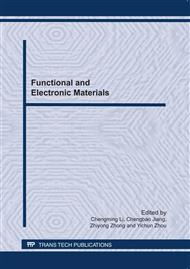p.391
p.396
p.402
p.407
p.411
p.416
p.422
p.427
p.433
Study on the Effects of (Bi1/2Na1/2)TiO3 Content on the Curie Temperature of (Bi1/2Na1/2)TiO3-BaTiO3 PTCR Ceramics
Abstract:
Perovskite-structured (Bi1/2Na1/2)TiO3 (BNT) ferroelectric with Curie temperature about 320°C is considered to be a good candidate of high temperature lead-free materials with a positive temperature coefficient of resistance (PTCR). In this study, lead-free PTCR ceramics with compositions of (1-x)BaTiO3-x(Bi1/2Na1/2)TiO3 (BT-BNT x=0.5-55mol%) were successfully prepared without any additional donor or acceptor dopants. The effects of BNT content on the Curie temperature Tc and the PTC effect of the ceramic materials were investigated. The X-ray diffraction data indicated that BT phase and BNT phase formed a solid solution during sintering even though the x value was up to 55mol%. The Curie temperature Tc of the samples increased from ~130°C to ~216°C with the increase of the BNT amount (x value) from 0.5mol% to 40mol%. However, it decreased when excess BNT was added (x value increased from 40mol% up to 55mol%), which was resulted from the volatile effects of Bi3+ and Na+ ions during sintering. The sample of 0.6BaTiO3- 0.4(Bi1/2Na1/2)TiO3 with Tc =216°C, room-temperature resistivity 104 Ω·cm and Rmax/Rmin= 102.7 was obtained. There is a relationship between the Curie temperature and the cell volume of the perovskite structured lattice.
Info:
Periodical:
Pages:
411-415
Citation:
Online since:
June 2011
Authors:
Price:
Сopyright:
© 2011 Trans Tech Publications Ltd. All Rights Reserved
Share:
Citation:


